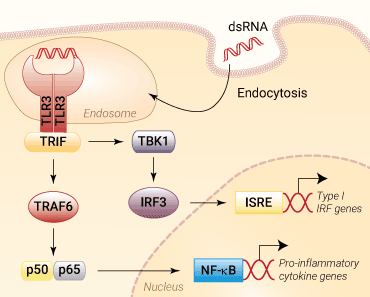TLR3 Ligands
 InvivoGen also offers:
InvivoGen also offers:
• HEK-Blue™ TLR Cells: SEAP-NF-κB Reporter Cells
• HEK-Dual™ TLR Cells: SEAP-NF-κB & IRF-Lucia Cells
InvivoGen provides synthetic dsRNA-based agonists known to activate TLR3
Toll-like receptor 3 (TLR3) recognizes double-stranded RNA (dsRNA), a hallmark of viral replication, and triggers antiviral immune responses [1]. TLR3 is expressed by immune cells, but also transformed cells, as described in several epithelial cancers [2]. Therefore, TLR3 expression and signaling pathways in normal and malignant cells make it a one-of-a-kind target for the development of prophylactic anti-infectious and therapeutic antitumoral vaccine adjuvants.
InvivoGen offers a growing library of functionally tested synthetic TLR3 agonists:
- Poly(I:C) & Poly(A:U) - dsRNA analogs of different sizes in a free or labeled format
-
NexaVant™ - a dsRNA of defined size with high molecular homogeneity
Each ligand's specificity, activity, and potency are vigorously tested using our HEK-Blue™ and HEK-Dual™ TLR reporter cell line collection. Moreover, each lot is functionally tested and guaranteed free of microbial contaminants. For vaccination studies, InvivoGen supplies Poly(I:C) and NexaVant™ in a pre-clinical VacciGrade™.
![]() Read our review about TLR3: racing for vaccine advantages.
Read our review about TLR3: racing for vaccine advantages.
Background
The first vaccine adjuvant candidate for TLR3 was a synthetic analog of dsRNA known as polyinosinic-polycytidylic acid (poly(I:C) or poly(rI):poly(rC)). Poly(I:C) comprises a strand of inosine poly(I) homopolymer annealed to a strand of cytidine poly(C) homopolymer. Since each strand is synthesized enzymatically, the size of each product can vary significantly - between 1.5 to 8 kb. Probably due to this undefined chemical structure and poor homogeneity, Poly(I:C) was reported to have toxic side effects in humans [3]. Continual efforts to find potent and lot-to-lot reproducible TLR3 agonists have led to the development of NexaVant™, a synthetic, cGMP grade, 424 bp dsRNA generated through in vitro transcription of a viral nucleotide segment [4]. It exhibits extreme homogeneity and absence of serious toxicity in preclinical studies [4].
References
1. Chen Y, et al., 2021. Toll-like receptor 3 (TLR3) regulation mechanisms and roles in antiviral innate immune responses. J Zhejiang Univ Sci B.;22(8):609-632.
2. Chen YG, Hur S. 2022. Cellular origins of dsRNA, their recognition and consequences. Nat Rev Mol Cell Biol. (4):286-301.
3. Zhao, T, et al., 2023. Vaccine adjuvants: mechanisms and platforms. Sig Transduct Target Ther 8, 283.
4. Ko KH, et al., 2023. A novel defined TLR3 agonist as an effective vaccine adjuvant. Front Immunol. ;14:1075291.





